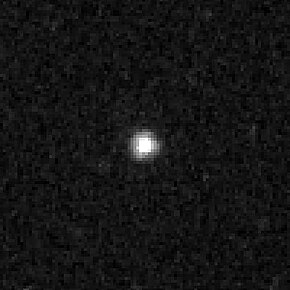 2001 QF298 imaged by the Hubble Space Telescope in 2006. | |
| Discovery[1] | |
|---|---|
| Discovered by | Marc W. Buie[2] Cerro Tololo (807) |
| Discovery date | August 19, 2001 |
| Designations | |
| 2001 QF298 | |
| none | |
| TNO[3] · plutino[4][5] | |
| Orbital characteristics[3] | |
| Epoch 13 January 2016 (JD 2457400.5) | |
| Uncertainty parameter 3 | |
| Observation arc | 4526 days (12.39 yr) |
| Aphelion | 43.726 AU (6.5413 Tm) |
| Perihelion | 34.756 AU (5.1994 Tm) |
| 39.241 AU (5.8704 Tm) | |
| Eccentricity | 0.11429 |
| 245.82 yr (89784.4 d) | |
Average orbital speed | 4.73 km/s |
| 154.29° | |
| 0° 0m 14.435s /day | |
| Inclination | 22.408° |
| 164.24° | |
| 41.215° | |
| Physical characteristics | |
| Dimensions | 408.2+40.2 −44.9 km[6] |
| 0.071+0.020 −0.014[6] | |
| B−V=0.67 ± 0.07 V−R=0.39 ± 0.06[6] | |
| 5.43 ± 0.07,[6] 5.2[3] | |
(469372) 2001 QF298, provisionally known as 2001 QF298, is a resonant trans-Neptunian object that resides in the Kuiper belt in the outermost region of the Solar System.[6] It was discovered on August 19, 2001 by Marc W. Buie.[2] 2001 QF298 is a plutino, meaning that it is locked in a 3:2 orbital resonance with Neptune, much like Pluto.[6]
- ^ Cite error: The named reference
MPEC2001-T54was invoked but never defined (see the help page). - ^ a b "List Of Transneptunian Objects". Minor Planet Center. Archived from the original on 19 June 2007. Retrieved 10 May 2012.
- ^ a b c Cite error: The named reference
jpldatawas invoked but never defined (see the help page). - ^ "MPEC 2006-X45 : Distant Minor Planets". Minor Planet Center & Tamkin Foundation Computer Network. 21 December 2006. Retrieved 24 July 2008.
- ^ Marc W. Buie (12 June 2006). "Orbit Fit and Astrometric record for 01QF298". SwRI (Space Science Department). Archived from the original on 14 February 2012. Retrieved 24 July 2008.
- ^ a b c d e f Cite error: The named reference
Herschelwas invoked but never defined (see the help page).